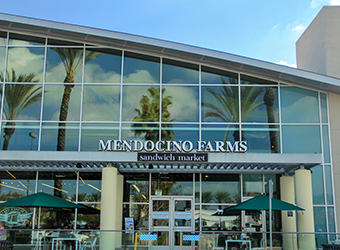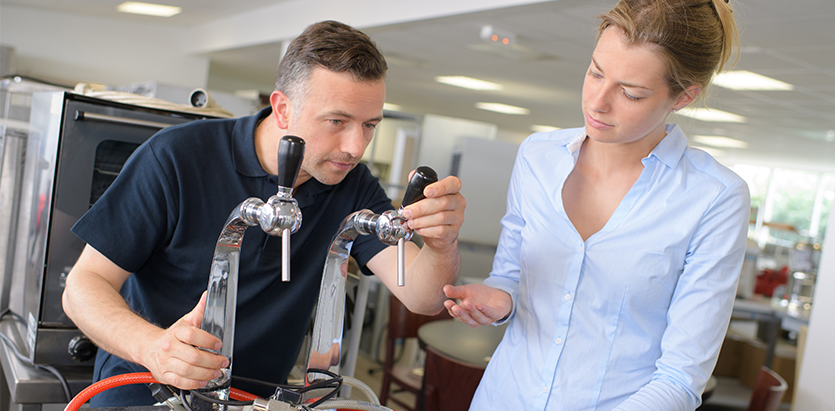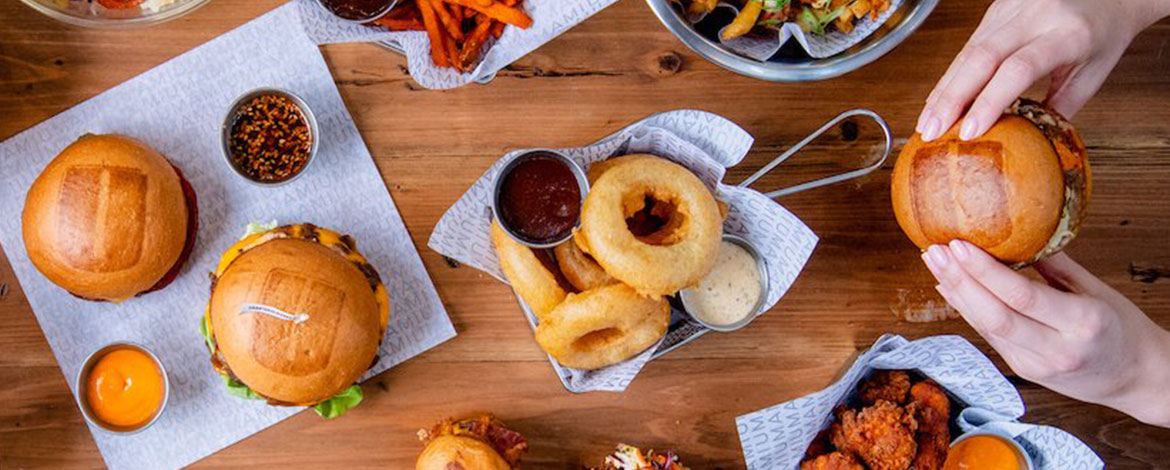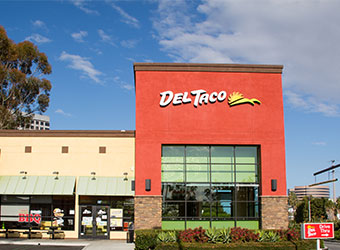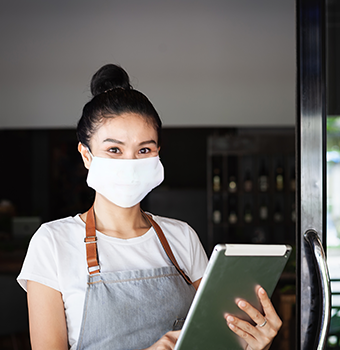For some, going to a restaurant is all about the food. For others, the excitement is tied to the experience. If the place has a gimmick, a mini-golf course out back or a waitstaff that belts out showtunes, that just makes the appetizers all the more appetizing.
For us, the sweet spot is somewhere in the middle. While great food engages your eyes, nose, tastebuds and stomach, eating it in a standout environment stimulates your mind and soul as well. All in all, it’s the perfect meal — and it looks way cooler on Instagram.
With that in mind, below are a list of amazing restaurants from coast to coast that will get your mouth watering, your anticipation building, and make you feel like you’ve found the perfect intersection of setting and sustenance. What do the restaurants on this list all have in common other than a killer vibe and delicious food? Answer: They are managing their restaurant facilities with Ecotrak. Check out 13 of our most Instagramable restaurants. How many have you visited?
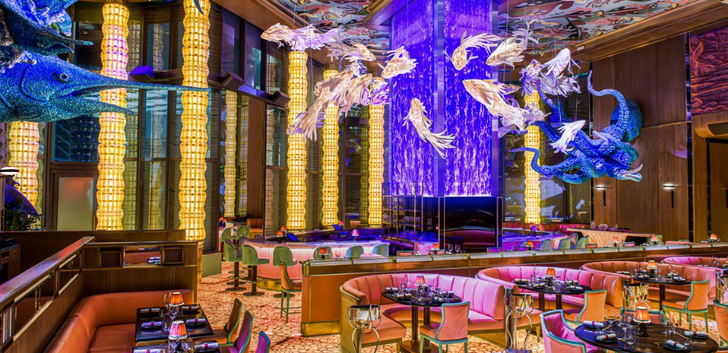
Sexy Fish (Miami)
The motto of this Florida hot spot is “looks as good as it tastes,” and you’d be hard pressed to find food as visually appealing as their Crispy Duck & Watermelon salad with pomegranate, Golden Fish & Crispy Caviar, Beef Tartare with Perigon Truffle or Busby Berkeley-like arrangements of sashimi, gyoza and tempura for days. Surrender yourself to the allure of the omakase, and Sexy Fish’s highly-trained chefs will leave you walking on air.
But if you can turn your gaze away from the table long enough, you’ll be captivated by what has been called “Miami’s most opulent dining room,” fueled with eye-popping artwork by artist Damien Hirst, Frank Gehry-designed fish lamps, and interiors designed to evoke ocean motifs and mid-century brasseries.
As the evening begins, order yourself a theatrical cocktail like the “Smoke & Peppercorn” (pink peppercorn-infused mezcal and sancho pepper tequila), the “Raspberry & Yogurt” (a Grey Goose punch) or “Pumpkin & Spice” (pumpkin and chai cordial with gin, served in a coral-inspired glass) and prepare yourself for something even showier. Mermaid dancers bring “Sexy” back alongside famed DJs and other out-of-this-world showstoppers. Plug into the wind and percussion instruments transporting patrons on an underwater musical adventure, and as the champagne and tequila flows, you’ll be hooked.
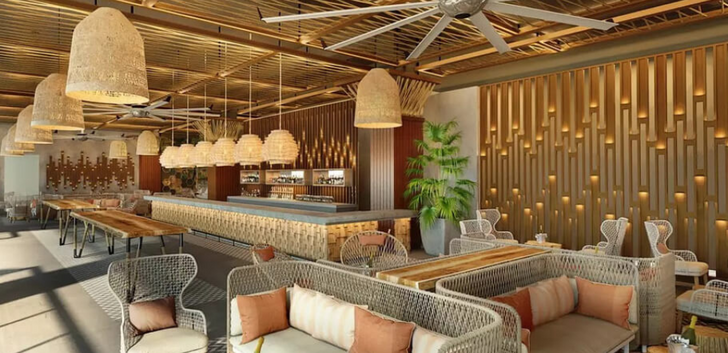
Kassi Beach House (Las Vegas)
In the Gambling Capital of the World, there are so many dining options that it’s easy to get lost. But this Italian coastal alternative, located inside the Virgin Hotels, is no roll of the dice.
The vibe here is the equivalent of attending a celebration at the most amazing beach house you’ve only seen in movies. The dress code is bikinis and trunks, signature punch bowls serve communal cocktails for the table, and it’s all steps from the pool (and reservation-only daybeds), under a disco ball with a thumping musical beat.
The interior is a stunning mix of wood and wicker, boasting huge wraparound booths and walls of ornate ceramics. The daily brunch is a place to see and be seen, as you sip bottomless rose and try a truffle pizza. In the evening, family-style meals, tomahawk steaks and made-in-house pastas are counterbalanced with bottles of wine, negronis and Japanese penicillin.
Imagine yourself and five of your besties, sharing a poolside daybed and sipping Subtropic slushies. What’s the Italian word for paradise?
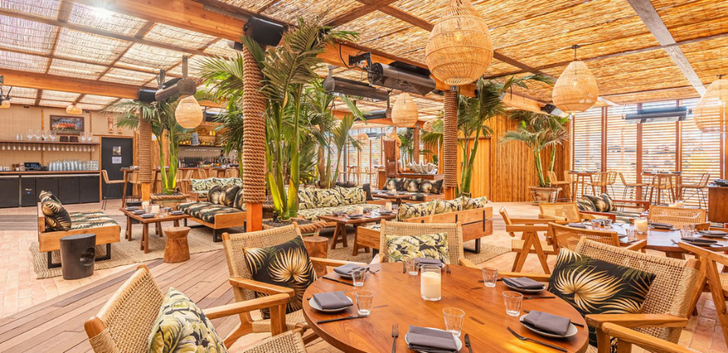
Belles (Venice, CA)
Tiki culture dates all the way back to the 1920s, when South Pacific-tinged dreams of escape first took hold of American culture. Embracing that mindset but stripping away the kitsch, Belles Beach House boasts island vibes and open-wood slats that let a cool breeze blow across one of the best cheeseburgers in town. Then, of course, there are the drinks.
Slip into a flowered booth and sip on a “Heat Stroke” (tequila, passion fruit, mango and smoked cayenne salt), a “Watermelon Mezcal Margarita” or “Seven samurai” (Japanese whiskey, lemon, sour apple, pear and ginger). Feeling social? Get your cocktail of choice in a punch bowl, and watch new friends flock to your table.
Look up from your drink and take note of the one-of-a-kind tiki totem lamps smiling back at you. Thankfully, it isn’t considered impolite to not offer them some of your Lobster Hand Rolls, Butterfly Branzino or Char Siu Pork Ribs with a pineapple glaze. Tiki is a way of life … and sitting in this slice of surfer nirvana, overlooking the Venice Beach boardwalk, another fresh-pressed drink with tequila will get you right where you need to be.
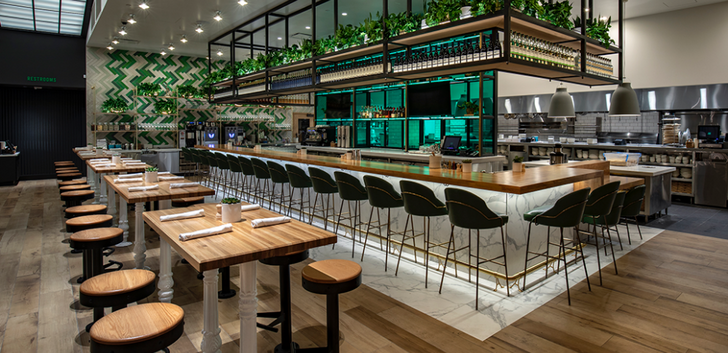
True Food Kitchen (Nationwide)
Employing freshness, seasonality and the principles of Dr. Andrew Weil’s anti-inflammatory diet as its foundations, True Foods has taken a lifestyle once out of reach for most Americans and spread it across 17 states — and growing. Describing their menu as “Fundamentally based on science,” True Food believes that better food leads to better lives, but don’t think such focus on sourcing, sustainability and nutrition robs the food (or their dining rooms) of flavor.
Walking into a True Kitchen, the first thing you notice is that the guests, the dining room and the kitchen have all blended into one ecosystem. It underlines the notion that we’re all on this mission together. The bright, airy restaurant is surrounded by produce and productivity, as culinary experts prepare bright, colorful dishes with potent ingredients like turmeric, broccolini and bok choi. And don’t sleep on the scratch bar, juicing fresh ingredients and preparing syrups for brunch cocktails like the Watermelon Mimosa.
To underline the mentality of a healthy body being in alignment with a healthy mind, True Food Kitchens have been known to offer yoga classes. So stretch your body — and your palate — at a True Food near you.

The Eveleigh (West Hollywood)
The best restaurants are expertly paired with their location, like a great wine and cheese. Look no further than Eveleigh, a country comfort restaurant that opened in its inviting, homey residence about a dozen years ago but feels like it’s been there since the structure was built upon an orchard in 1923. Brunching off the Sunset Strip, as the California sunshine pours through olive tree branches and onto your Dungeness Crab Pasta, you’ll feel perfectly paired as well.
A vine-covered pergola welcomes diners to the outside patio. Indoors, a dining room every bit as bright frames a bartender, working hard on your next favorite cocktail. Whether you want to try a “Negroni Chupacabra” (mezcal, aperitivo, vermouth and prickly pear), “Inbetween Days” (vodka, vermouth, grapefruit, thyme, lemon and soda) or a “Unicorn Juice” slushie, you can’t go wrong.
The Eveleigh really comes to life, however, for large groups gathered around the communal table for 15 (nestled under a retractable, open air roof) or the back patio with a view of the city. Grab some friends, share some sips, and you might find yourselves debating whether The Everleigh is prettier during the day or at night.
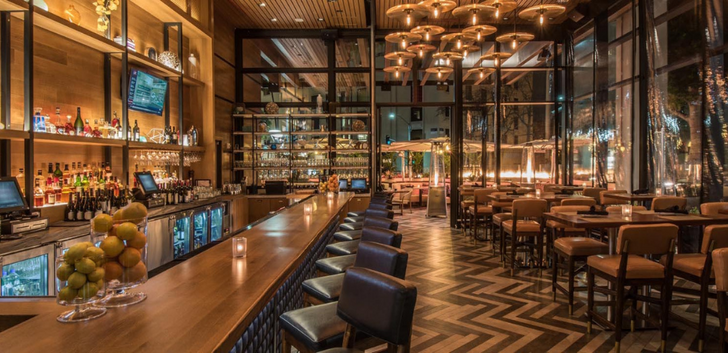
Ocean Prime (Nationwide)
When chef Cameron Mitchell was growing up in Ohio, he used to sit at his mother’s kitchen table and dream of opening elegant fine dining restaurants from coast to coast. Now, his Ocean Prime restaurants are serving up steaks, seafood and cocktails in 18 stunning dining rooms from Beverly Hills to Boston.
Every Ocean Prime feels like its own art gallery, but rather than impressionist paintings on the walls, everyone is oohing and aahing at the Twin Lobster Tails, Colorado Lamb Chops or mouthwatering sides like Black Truffle Mac & Cheese. In Beverly Hills, the massive booths envelop you while you marvel at walls of immaculately-arranged wine bottles. Dallas has smokey slatted windows and a modern outdoor firepit. From the jellyfish-like lamps in Indianapolis to the magnificent coral in Philly, each location seems intent on one-upping the others in opulence.
At the center of it all, however, is Mitchell’s meticulously-orchestrated menu. Taken together, the experience is a spectacle that thrills you from the inside out —it’s enough to make any mother proud.

Katsuya (Nationwide)
Arguably the progenitors of modern art-is-everywhere dining, master sushi chef Katsuya Uechi and design maestro Philippe Starck have spent a decade launching stunning locations from Hollywood to Manhattan. Each is a reflection of its location, from the chill vibes of Brentwood to pulsating South Beach, whose location in SLS South Beach boasts a Tower Penthouse designed by Lenny Kravitz and featuring unique, curated dishes and vintage vinyl.
In New York, diners congregate under Japanese uchiwa fans while devouring Chef Katsuya’s signature Baked Crab Handrolls. In the Bahamas, traditional Japanese cuisine is mixed with California style surrounded by dangling chandeliers and striking art. In Hollywood, servers shout “irashaimase!” before you get to work sipping a “Burning Mandarin” and nibbling on Crispy Rice with Spicy Tuna in their black-and-gold dining room.
Whether sitting in the sushi bar or holding court in a dining room made to see and be seen, Katsuya has spent a decade as the gold standard.
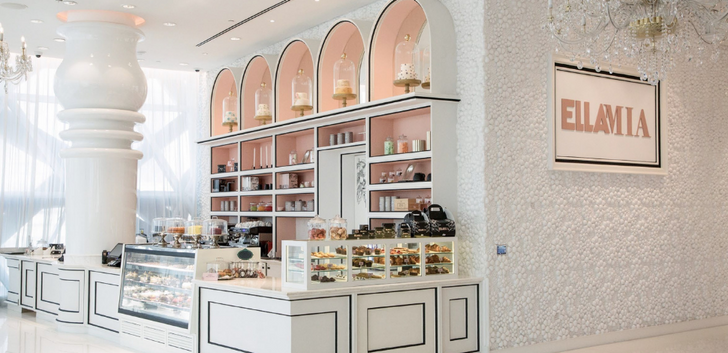
Ella Mia (Worldwide)
To some, coffee is a necessity. To others, it’s a ritual.
Pay your respects to the most sacred of beans in these sophisticated, contemporary spaces that couldn’t be further removed from your grandpa’s coffee shop. Whether you’re in Doha or Dubai, New York or London, you’re bound to have your eyes opened — and not just by the caffeine.
Each EllaMia has a clean, distinctive look marked by brightness and warmth. Glass cases display amazing pastries, including tarts and cakes. Sip on a Rainbow Latte, enjoy it with a slice of Fig & Rose cake, and wonder if this might just be Willie Wonka for grown-ups.
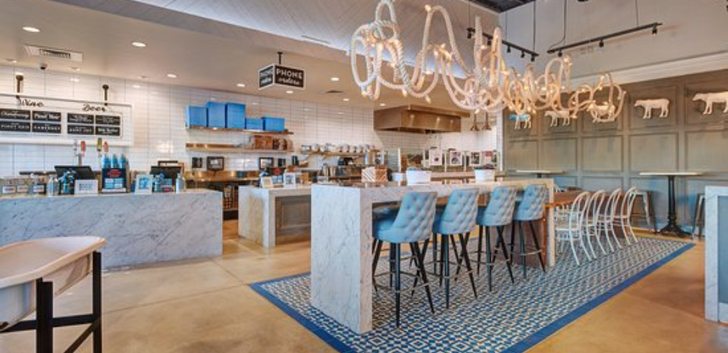
Mendocino Farms (Western US)
When you’re looking for sandwiches, salads and other foodie faves that are fast — but most decidedly not fast food — look for the blue cow.
Since 2005, this rapidly-growing chain (mostly throughout California, now expanding into Texas) has been the go-to for lunchtime treats like the Sweet Heat Crispy Thai Chicken Sandwich, Mrs. Goldfarb’s Unreal Reuben and Pork Belly Banh Mi (with a vegan version, for those so inclined). But the “Soulful Salads,” with ingredients like avocado, quinoa, grape tomatoes, pink lady beets and Impossible chorizo, are delicious enough to make you forget you’re eating so healthy.
If you catch their seasonal specials at the right time, you might be able to snag the delectable Oaxacan Potato Salad or mouthwatering Thai Watermelon & Cucumber Salad. Enjoy it all in a clean, bright dining room with whimsical details like foosball tables, turf-lined seats, and cows on the wall. Most locations also have a children’s play area, so you can enjoy a Chimichurri Steak & Sashito Bowl while your little critters enjoy time on the farm.
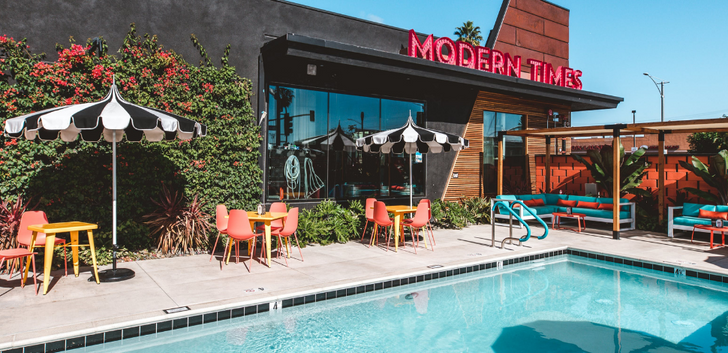
Modern Times Brewery (Anaheim)
The OC’s “Leisuretown” aims to be a permanent block party, and anchoring it all is Modern Times — the collection of brewers, coffee roasters and culinary experts who formed a Justice League-like cadre of flavor in 2013, opening a brewery and tasting room in Point Loma.
This, their fourth location, is also the most off-the-wall. A combination brewery, restaurant, café and swim club, the property is anchored by a serene swimming area whose stated mission is to put visitors “in a dimension of epic and abiding chillness.” Bringing the leisure to Leisuretown, a brightly-colored pop art bar houses 70 brews and ciders on tap, house-roasted coffees and an extensive wine list.
Their 100 percent plant-based menu includes no-brainers like avocado toast and corn fritters, but also outside-the-box dishes like “Fuegolote” (fried corn on the cob with house-made tajin) and the “Munchwrap” (Impossible taco mix, queso and more in a flour tortilla). Swing by their mini-mart for some “sexy merchandise,” order a flight, and find yourself a sun lounger by the pool. Instant glimpses for The Gram.
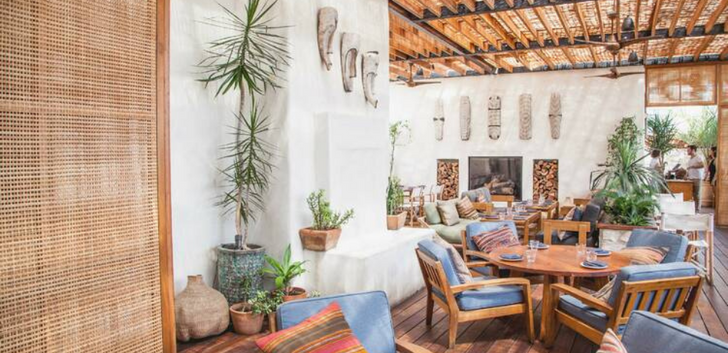
Elephante (Santa Monica)
Who doesn’t dream about owning a beach house, enjoying pitchers of cool drinks and amazing food? Dream no more; just get to Elephante at sunset.
Patrons of this rooftop bar and restaurant enjoy a Southern Mediterranean chill without needing to board a plane. The flavors of Italy inspired hand-crafted cocktails like “The Book Thief” (nosotros respado, cocchi rosa, lime, honey, peach and allspice), “Golden Hour” (bourbon, apple, lemon, vanilla and cinnamon bitters) and a “Coconut Negroni” keep things cool. Enjoy one (or three) with some Polenta & Mushrooms, Diver Scallops or a family-style Veal Milanese for the perfect evening.
The real show here, however, is on par with any band or DJ you could hope to hire. Every evening, the patio is packed with onlookers, watching the one-of-a-kind Southern California sunset into the Pacific Ocean. At Elephante, it’s an experience you’ll never forget.
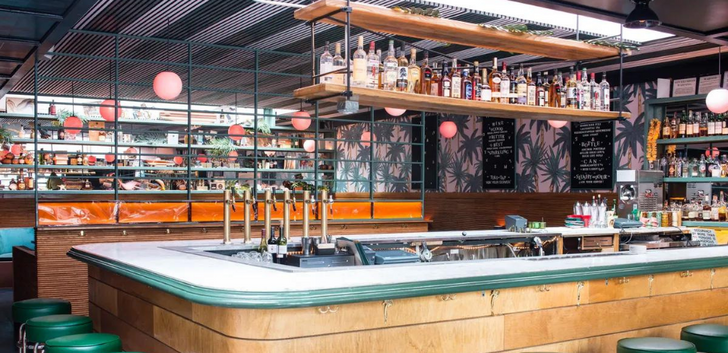
The Happiest Hour (New York)
Cartoon palm trees, flamingo tchotchkes, whimsical drinks, diner-style food and a rock ‘n’ roll soundtrack — what could be happier? This New York hotspot opens weeknights at 5pm and keeps the happy hour vibes going all night long, and there’s no better place to unwind after a hard day at the office.
Grab some co-workers and order up a bunch of Mac + Cheese Bites, Loaded Tater Tots or Extra Crispy Wings for the table. Then design your own “mule kick,” “pineapple express” or “ice cuba” — just pick your spirit, and they’ll happily pour. If a cocktail pitcher or bucket o’ beer is more your style, there are no judgements here.
Perhaps the most “must try,” however, is the so-called “Happiest Burger.” Zagat ranked it as one of the hottest burgers in NYC, Thrillist called it “absolutely delicious,” BlackBook described it as “impossibly mouthwatering” and a national burger critic ranked it among the best burgers in America. At the Happiest Hour, this amalgam of burger, bun and bliss shines even brighter than the disco ball hanging from the ceiling.
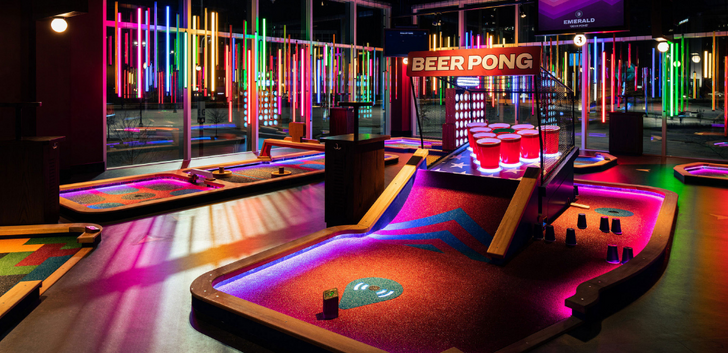
Puttshack (Nationwide)
First, we got nightclub bowling alleys, then nightclub axe-throwing and driving ranges, and now comes a similarly beloved pastime receiving a 21st century update: Mini-golf.
Meet Puttshack, a fast-expanding chain that brings food, drinks and fun to a game now going decidedly high-tech. Faster than you can scream “Holey Moley,” you’ll be hooked on this version of putt-putt, powered by “Trackaballs” with sensors in them that allow the game to keep score for you: A hole in one is worth 50 points, 5 swings is worth 25, if you need more than 10, well, the game mercifully stops counting. There are hazard traps that threaten to rob you of points, Supertubes that can give your ball an express lane to glory, and themed holes like “Prize Wheel” (where a “Price is Right”-like wheel can win you pizza), “Beer Pong” (hit your ball in the “Freshman” cup for a Supertube hole-in-one) or “Ring of Fire” (are you enough of a daredevil to try and knock your ball through the hoop?).
Sip a beer while you take your swings, then adjourn for some world class cuisine that couldn’t be further from amusement food. Flatbread Pizzas, Empanadas, Rendang Bao Buns and Tuscanu Pork Porchetta sandwiches might make you feel like you’re eating in a fancy restaurant, even if you are within eyeshot of a sign that reads: “Oh my God, Becky, look at her putt.”
INDUSTRY INSIGHT
What's Happening at Ecotrak
Meredith Sandland and Carl Orsbourn, food industry leaders, are the co-authors of the new book Delivering the Digital Restaurant: Your Roadmap to the Future of Food.
Focusing on the rise of off-premise business and digital interfaces in the restaurant industry, their insights will resonate with facilities managers and any restaurateur looking to navigate the new normal.
How is automation and technology transforming facilities management and off-premise businesses? Here are some of the key takeaways from the book, available now at www.deliveringthedigitalrestaurant.com (use ECO25 for Ecotrack’s exclusive 25% discount).
Focusing on customer-centric & off-premise business
According to Delivering, the COVID-19 pandemic only accelerated disruptive trends that were already in motion. Restaurants now need to “shift how they think, behave, and invest to survive and thrive” to keep up with today’s consumer.
Consumers are demanding from restaurants what they’ve already been demanding from retail: quality and convenience, when and where they want it. Restaurants that can provide good quality food, with a frictionless, on-demand interaction, will be able to capitalize on new opportunities.
While some restaurants want to “return to normal,” Delivering argues that the baseline has fundamentally changed and is requiring new investments in technology. “The change in the consumer is creating the reason for technological investments to be made, not the other way around,” said co-author Meredith Sandland.
“The customer is now the center of your technological universe,” added Carl Orsbourn, co-author. “You need to make your decisions based around how to improve the consumer journey and your own engagement with the consumer. This means using data.”

Transforming the industry because “digital is not optional”
According to Delivering, “running a successful restaurant in the 21st century requires not just great food and great service—it also demands an understanding and application of technology.”
Sandland admitted the challenge of incorporating technology into business is difficult. She gave the example of a small chain restaurateur reporting that he received at least 10 emails or phone calls a day from companies trying to sell software and tech services, and he struggled to find the one that matched his restaurant needs. “The number of new technology solutions out there is so high, it can be completely overwhelming,” she acknowledged.
But while it may be a challenge, Sandland strongly advocated that technology offers a better way to operate a restaurant.
As the former Chief Development Officer for Taco Bell, she has deep experience with facility management. To streamline the time-consuming nature of maintaining and repairing equipment, the maintenance team used custom in-house software years before such things were widely available. These in-house solutions “allowed us to add efficiencies that other, smaller restaurant chains couldn’t access” while tracking service tickets and preventative maintenance.
“Before, it took a giant company like Yum! Brands [parent company of Taco Bell], with a huge balance sheet, to build these incredible technologies that only they could have. They needed a scale of all their restaurants to really have it make sense,” Sandland said.
“The new ‘SaaS-ification’ of technology is remarkable,” she continued. As software as a service (SaaS) companies grow offerings for technology and automation, smaller restaurant companies now have access to the same innovative software that can transform operations.
“Now, anyone can get these things for a monthly fee. I think it levels the playing field between the really big restaurant companies and the smaller ones,” she added.
Automating as much as possible
Now that efficient technology and software is available to restaurants, Sandland and Orsbourn advocate for facilities to take advantage of it as much as possible, particularly through automation.
Sandland explained that restaurant managers are responsible for a dizzying array of tasks, from HR to facilities to food and customer service. “If you can automate with software as much as possible, so that the heavy lifting is being done in a replicable and scalable way—I think it's critical for an operation to run effectively,” she explained.
Investing in automation can benefit restaurants particularly as labor costs continue to rise. Adding in new layers like remote management, or automation that increases speed of off-premise order aggregation and fulfillment, allows restaurants to cope with new challenges.
While it can be time-consuming at first, Orsbourn recommended following your own “technology road map” to understand what tech you need, when. How you implement automation, he said, depends on “where you are in your journey towards digital maturity”. The co-authors recommended starting by examining where there may be a cost problem, top line issue, or a bottleneck in tasks.
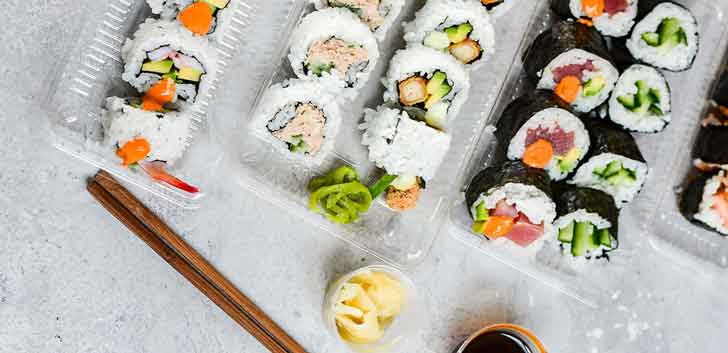
Leveraging scale in off-premise opportunities like ghost kitchens
Delivering the Digital Restaurant also discusses the rise of ghost kitchens, restaurants that sell food without a front-of-house brand presence. These facilities may house multiple concepts within the same space, providing new efficiencies for utilities, labor, supply chain, and building costs.
Opportunities of scale can provide enormous benefits for facility management, said the co-authors. For example, for facilities that struggle to get out of a loop of reactive maintenance, ghost kitchens provide an opportunity to get ahead of preventative maintenance. With a density of restaurants in one location, said Sandland, “you can set up relationships with vendors to come in and do preventative maintenance in a way that's much more scalable for the vendor—and potentially get a discount on that as a result.”
The density also provides opportunities of scale for technology solutions as well. With the consumer demand for speed in off-premise sales and delivery, “that sets up a whole world of automation that can come in and make that process more efficient” in ways that might not apply to a smaller restaurant, added Sandland.
Increasing efficiency in facility management with new technology solutions
Facilities managers are at the forefront of using technology in a customer-centric, off-premise world. Sandland and Orsbourn highlighted multiple areas for facilities management professionals to focus on.
For example, Sandland explained that as consumers come back to dine-in, being up-to-date with repairs for items that consumers can see, touch, and feel is critical to a positive customer journey. While this may not have been a priority for facilities in the past year of minimal in-house sales, now, said Sandland, “if customers see things in front-of-house that are broken, they start to wonder what’s going on in the back-of-house.”
Orsbourn highlighted the need to prioritize building trust with consumers. The “open kitchen” model had been popularized in recent years, so customers could see their food being prepared. Now, in a world of food delivery and ghost kitchens, “all of that is hidden away,” said Orsbourn. The possibility of eventual trust or disconnection issues makes maintaining facilities and any customer-facing facilities more critical than ever.
Technology is also helpful for “monitoring kitchen usage as efficiently as possible”, said the co-authors.
Orsbourn shared that as “virtual brands” in ghost kitchens start to share spaces, “slightly movable pieces of equipment can help virtual brands in a more effective way” through an adjustable kitchen configuration. “I think there will be ways in which facilities managers are going to have to be able to understand the modularity of the kitchen to accommodate that,” he added.
Orsbourn also highlighted the major development of these off-premise kitchens: while restaurant revenue used to be limited by number of tables and turn times, for a model like a ghost kitchen, the limiting factor is actually the maximum throughput capacity of a kitchen.
“If I did have an infinite amount of tables out there, how many dishes could I truly push out through this kitchen? And what would I need to do to make that happen?” he said. Facility management is primed to take center stage as restaurants consider investing more in remodeling back-of-house instead of front-of-house.
Sandland agreed, adding, “I think there will be a lot more attention turned to the back of the house. How is it set up? What equipment is in it? What needs to be replaced? What should be more efficient? What should be more automated? The facilities management team typically gets to implement those decisions.”
Conclusion
As these developments take over the industry, it is clear that automation and other smart solutions in facilities management are more important than ever.
Interested in learning more takeaways from Delivering the Digital Restaurant: Your Roadmap to the Future of Food? Grab a copy of the book to learn more from Carl Orsbourn and Meredith Sandland’s industry insights (go to www.deliveringthedigitalrestaurant.com and use code ECO25 for a 25% discount and free shipping).
And if you are thinking about how facility management software can help your facility or ghost kitchen thrive in this new technology-driven world, consider exploring a facility management software solution such as Ecotrak. Using a Computerized Maintenance Management Systems (CMMS) can help you track equipment in ghost kitchens and other off-premise businesses to thrive in today’s new restaurant industry.
INDUSTRY INSIGHT
What's Happening at Ecotrak
Image Credit: Umami Burger
Some people might tell you the restaurant industry is at a crossroads. Adam Rinella, however, will be the first to tell you that it’s actually at the intersection of about a dozen crossroads.
“It’s really exciting to be at the end of the tunnel and seeing the light,” Rinella, the Senior Vice President of Development at C3 says after a year lost to COVID-19 lockdowns, yet one that has afforded smart industry execs the time to plan a path forward. “There’s a pent-up demand right now. We’re seeing sales in the markets that have re-opened early — Texas, Florida — that are 20 percent higher than they were in 2019. People want to go out, they want to go to restaurants and get back to regular life.”
A division of lifestyle hospitality company SBE, C3 spent much of 2020 navigating the unprecedented pandemic — while simultaneously exploring opportunities via ghost kitchens, celebrity influencers, software development and food halls that Rinella sees as potential ways to capitalize on this “pent up demand” and emerge with a business stronger, smarter and more nimble than ever before.
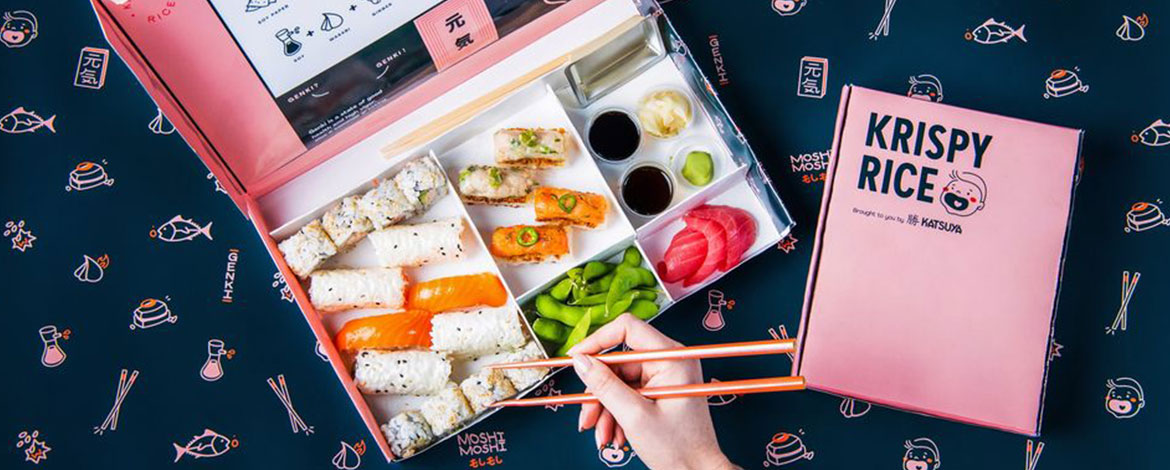
Image credit: Krispy Rice
Maintaining the culture
“We operate 20-plus brands, and we do that through a variety of kitchens,” Rinella says of a C3 roster list that includes big names like Katsuya and Umami Burger, paired alongside rapidly growing delivery-only concepts (at least for now) like Sam’s Crispy Chicken, Plant Nation and Krispy Rice — which saw triple its expected business during the shutdown and currently has 40,000 followers on its lively Instagram without so much as a single location.
Even before shutdowns accelerated mass adoption of delivery apps, C3 experimented with “ghost kitchens” and “dark kitchens,” but the company quickly realized such departures didn’t promote the sort of culture it wanted to embrace.
“We realized pretty fast that we’re in the hospitality industry, and when you eliminate the front-of-house piece, you lose that ability to connect with the customer,” he explains. “It was kind of a dismal operation.”
So instead, they pivoted to a plan where they would use existing kitchens in brick-and-mortar restaurants and hotels, simply setting up additional stations for the delivery-only brands. But even that plan, early on, had its hiccups.
“We figured out something really quickly,” Rinella laughs, remembering the confusion as drivers arrived at Umami Burger looking for a sushi restaurant. “The first day was a disaster. We had all these drivers showing up to the location, and they would put into the app ‘this restaurant doesn’t exist, it’s not here.’ We realized you’ve got to have some kind of way of finding signage for the drivers so they know they’re in the right place. We very quickly came up with a system of A-frame signs, wall signs and parking spaces.”
Now that those initial kinks have been worked out, C3 has positioned itself to thrive. Today, virtual and brick-and-mortar brands share space in their vibrant kitchens — and instead of retro-fitting such spaces to make room, future kitchens will be constructed with these shared-space learnings in mind.
“Now, we’re designing from scratch versus converting existing kitchens, and we’re designing them in a way that will cross-utilize equipment across brands and be set up in a way that considers which concept can be set up next to which concept — which will allow cross-utilization of equipment, labor and even ingredients,” he explains. “We’re getting things down to a science, and focusing on using every square inch of the kitchen to accommodate five, six, seven brands rather than just converting from an existing, single kitchen in a traditional restaurant.”
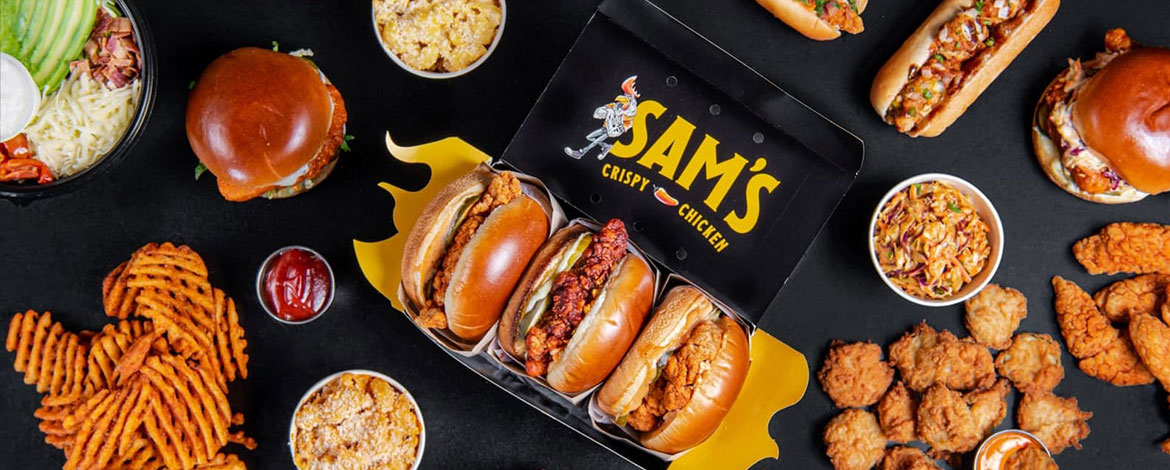
Image credit: Sam's Crispy Chicken
Friends in high places
When SBE began as a nightclub company in the early 2000s, founder Sam Nazarian learned how to harness the power of celebrity. Such lessons have carried over to SBE, and today the company’s well-established relationships with influencers are paying off.
“There are so many choices when you go on DoorDash or Postmates; you have to know how to stand out,” Rinella explains. “One thing that has been brought along from our legacy SBE days is the social influencers, the celebrities and other things that were part of the nightclubs being very popular. Now, when we’re building these fast-casual brands, whether it’s through a ghost kitchen or brick-and-mortar, if you have huge celebrities and social media influencers endorsing your brand through their social media, that can be a huge differentiator.”
Hollywood power couple John Legend and Chrissy Teigen have professed their love for Krispy Rice, with Teigen telling her 34.7 million Instagram followers “you must order from them, and do not skip the shrimp!”C3 has also been working with the likes of Justin Bieber and Diplo.
“Sam has genuine friendships with these people; he’s known them forever, so he introduces them to the food,” says Rinella. “They’re not going to endorse something unless they think it’s of quality, and it’s on-brand for them ... it’s an intrinsic quality of C3 that we attract those people and they want to be a part of it.”
With such connections in mind, Rinella watched closely as Jimmy Donaldson — the 22 year old YouTube sensation known as “Mr. Beast” — recently sold more than a million burgers during the pandemic by launching a ghost kitchen chain called MrBeast Burger in partnership with Planet Hollywood founder Robert Earl. The takeaway was clear: to successfully target Gen Z, look to their favorite YouTubers for branding opportunities.
“That was a huge success; people would order the food because they love Mr. Beast,” says Rinella. “So, we went out and partnered with several really big influencers ourselves, YouTubers with between 5 and 30 million subscribers. We’ll be creating brands with these people to do something similar; if you follow them on YouTube or Instagram, they’re going to have these little mini-brands based around them and the food they love, and people will be able to order that food through our kitchens all over the country.”
The difference, Rinella believes, will come from their high-quality brands. With C3 staff trained to not only create memorable food but also delectable food, the company is in a position to make such partnerships not only exciting, but also result in food actually worth eating.
“The way our kitchens are set up, with the equipment and skillset of our back-of-house employees, we’ll be able to produce everything at a very high level where it’s very good and craveable and people will want to re-order it,” he insists. “It will be the same sorts of followers, Gen Z marketing, but we’ll be hoping to execute these partnerships at a much higher level.”

Image credit: Plant Nation
Deck the halls
As the world reopens, Rinella has an eye on two additional emerging fronts: proprietary technology and single-ownership dining halls.
“We’ve created our own technology called CitizensGo, it’s a marketplace that launched a few weeks ago available on the web or via app,” he says. “You can build one cart from several different brands, have one financial transaction, and then have all the food come to you at once.”
If you’re looking to grab lunch for your family or office, CitizensGo eliminates the need to order from two or three different restaurants to satisfy everyone’s cravings. For the customer, the food arrives at the same time, paid in one easy transaction. For C3, instead of giving a sizeable percentage to a delivery app, they can negotiate a more reasonable fixed amount for last mile delivery.
“The fixed rate makes it more profitable and easier to plan. In addition, the data and customer account becomes your own, so you can get them into your loyalty programs and send them offers when you need to increase interaction,” Rinella says. “That’s the big pivot for us, trying to drive people through our own technology and originating the customer on our platform.”
But, there is still something to be said for dining in. So Rinella is always looking to carefully balance the tangibility of real-world locations with the flexibility of virtual brands.
“Rather than individual brick-and-mortar restaurants for all these brands, we’re building food halls,” he says of locations in various states of development in markets like Manhattan, Atlanta and Seattle. “We can say to a landlord, instead of negotiating with ten different tenants for ten different stalls and ten different rent checks, we have all these amazing brands we want to deploy in this community.”
The food halls give customers the type of choice they desire, and C3 the sort of opportunity to fine-tune plans on the fly that they embrace.
“We spread our brands throughout these stalls to make it a real brick-and-mortar place for these brands to live. If for some reason one of the brands doesn’t work in that community, we just quickly flip that stall to a different brand and see if that works any better,” Rinella explains. “So, the food is being deployed somewhere people can look and touch and feel, while we’re also putting those brands in the back of these restaurants and delivering others via virtual kitchens.”
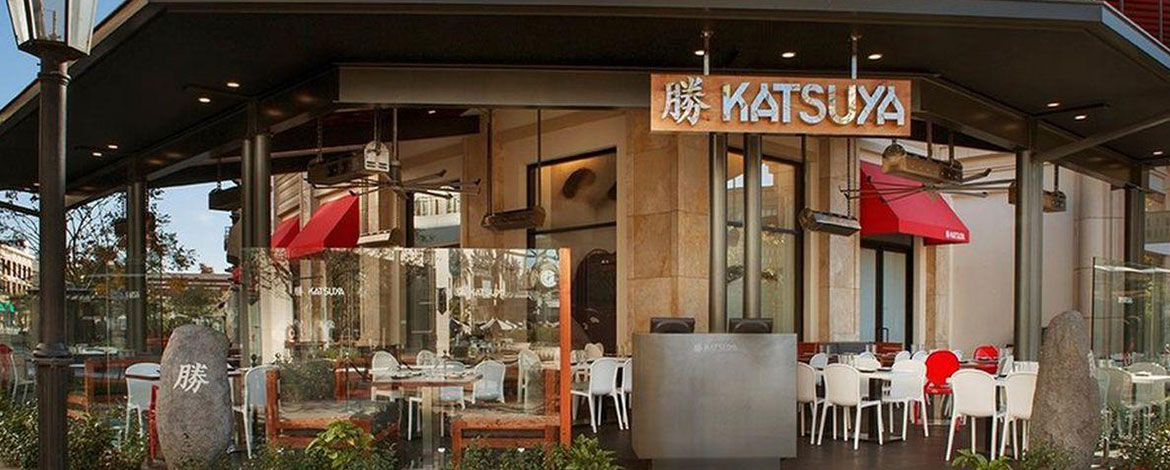
Image credit: Katsuya
Maximizing equipment, minimizing delays
With so many crossroads to be navigated, and so many bold ideas moving the company forward, C3 is thankful for a Facilities Management solution that empowers them to manage their equipment, find footing in new markets and increase operational efficiency.
“Our in-house facilities techs across the country are set up with vendors in Ecotrak,” Rinella explains. “For managers, that gives them the ability to send work orders to an in-house technician or vendor using a standardized system and protocols, whether they need an in-house person to come out, or a vendor.”
As Rinella and his team move from their California strongholds to expansions in Chicago, Austin, Miami, Atlanta and other markets, they also find it immensely helpful to have a system that recommends proven, competent local vendors.
“If it’s a new market, we’re able to get feedback and recommendations from Ecotrak on vendors in that market, and we can onboard them so that right away, when the store opens, the restaurant managers have the ability to place work orders if they’re having some sort of trouble with facilities,” says Rinella.
It also empowers staff at all levels to keep things moving in the right direction. “The facilities manager becomes an air-traffic controller, seeing everything and evaluating work orders as they come in, giving feedback to the managers and helping them troubleshoot, managing the technicians and the vendors,” he adds. “Ecotrak is a huge tool for being able to see the 30,000 foot view constantly, while at the same time managing individual work orders and problems in real time.”
With palpable excitement around the re-opening restaurant industry, and customers eager to interact with brands both established and new, virtual and otherwise, C3 is re-opening businesses with the confidence that they’re in a position to succeed.
“We’re growing incredibly fast,” says Rinella. “Having Ecotrak as a tool on the facilities side allows us to scale quickly.”
INDUSTRY INSIGHT
What's Happening at Ecotrak
Image Credit: Mendocino Farms Sandwich Market
Mendocino Farms opened its first cloud kitchen in Long Beach, California in November 2020. We caught up with Gene Davis, CRFP, Senior Director of Facilities, to talk facility management technology, cloud kitchens and how the brand fared during the pandemic.
Mendocino Farms recently implemented Ecotrak Facility Management Software. Why did you go with Ecotrak?
We were with ServiceChannel, and we switched to Ecotrak. I've spent a lot of time with ServiceChannel. I rolled out ServiceChannel in my last two companies, and Mendocino Farms already had ServiceChannel. I knew about Ecotrak, and after seeing their demos, I decided to switch. ServiceChannel served us well, but Ecotrak is more intuitive, easier to use, has more analytical tools, and for our younger managers, it's mobile-based and just a cooler technology. The other reason is the price. ServiceChannel and Ecotrak offer similar features, but ServiceChannel tacks them onto the price. Everything was a la carte. With Ecotrak, we get one price and all the features, and that was appealing to us.
How has your customer experience been with Ecotrak?
I've received great service during the transition. With ServiceChannel, if you have a problem, there's a help desk. You submit an email and it goes back and forth. Ecotrak has amazing support. They have somebody manning the phone 24/7. If I have a question, I like to pick up the phone and talk to somebody versus typing a message like a service request and then waiting for an email response. I’m in California; my stores are in California, and Ecotrak is based in California. I'm excited about having a better support system. That was a big factor.
How is the transition going?
It’s good. We have a client success person, Michael, who is great. It was easier than I thought it would be. The salesperson said, "This is going to be really easy." And I said, “Okay, great,” but I was skeptical. Nothing is easy, especially in facilities. Anything that can go wrong will go wrong. But we've had weekly calls. They've done a lion's share of the dirty work: the loading of assets and PMs. We're about to start the final phase: training. They have a great trainer and training program.
How have your restaurants fared during the pandemic?
Our brand is delivery heavy. That’s one of the reasons we've done so well during the pandemic. The brands that had drive-through and delivery in place made it through.
The company opened its first ghost kitchen. Why don’t you call it a ghost kitchen?
People call them ghost kitchens or virtual kitchens, but we say cloud kitchens. “Ghost” sounds like there's nobody there, but there are lots of people at our cloud kitchen.
Did Mendocino have a cloud kitchen before the pandemic?
No, we opened one in the middle of the pandemic. At the time, opening restaurants was difficult. It was easier to open a cloud kitchen. It shares a facility with 12 or 13 other concepts.
What challenges did you face with opening the cloud kitchen?
Two ways. They can use popular food-delivery apps, such as Grub Hub, Uber Eats, Postmates or Door Dash – we partner with all of them – or use the Mendocino Farms app. Customers can also pick up their orders. The facility has food lockers. A staff member tells them their locker number. It’s contactless since they paid on the app. On our website, it's promoted as “Long Beach Kitchen – Delivery and Pickup Only” to make that clear for guests so they don't get dressed up and show up for dinner at that location.
Does the cloud kitchen support catering?
Yes. Pre-pandemic, catering was an enormous part of Mendocino Farms’ business. We were known for our catering. So, we hope, as people go back to the office, and things slowly go back to whatever the new normal is, that we will be catering a lot more out of Long Beach.
Are there more cloud kitchens in Mendocino Farms’ future?
We've had great success with the first one. Sales are great. The Operation is great. So, we're looking at a couple of different sites – one by Berkeley and one in San Francisco. The small footprint makes it easier to add more to our portfolio. We're convinced that adding more kitchens will strengthen our brand.
What trends have you noticed?
Consumer behaviors have transitioned to online ordering. People like having their groceries delivered because of the convenience. This translates to cloud kitchens well. People will continue ordering food online for delivery or pickup. People get into a routine and it becomes the norm. People are used to it. They're comfortable with it, and they like the new way better in some cases.
Gene Davis , CRFP, is the Senior Director of Facilities at Mendocino Farms Sandwich Market.

